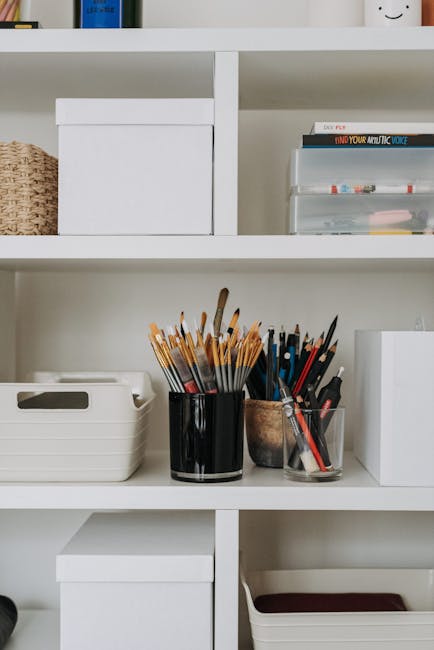
Desk Domination: Organizing for Focus and Flow
Understanding the Psychology of Workspace Organization
The human mind is wired to seek order. A chaotic desk, overflowing with paperwork and cluttered with unnecessary items, acts as a constant source of low-level stress. This chronic stress, even if subconscious, drains cognitive resources needed for focus, creativity, and problem-solving. Conversely, a well-organized workspace promotes a sense of calm, control, and efficiency. By consciously designing our desk environment, we can directly influence our psychological state and optimize it for productivity. The principle here leverages the concept of “situated cognition,” which argues that our thinking is deeply intertwined with the physical environment. A clean, streamlined desk signals to the brain that it’s time to focus, minimizes distractions, and fosters a sense of accomplishment.
The Pillars of an Organized Desk: Functionality, Accessibility, Aesthetics
Effective desk organization isn’t merely about tidying up; it’s about creating a functional and aesthetically pleasing workspace that supports your individual needs. Three pillars underpin this: Functionality, Accessibility, and Aesthetics.
-
Functionality: The desk should be primarily designed for its intended purpose. Consider the tasks you perform most frequently and arrange your tools and materials accordingly. A writer, for example, will need ready access to notebooks, pens, and reference materials, while a designer might prioritize drawing tablets and software. Functionality dictates the layout, ensuring that everything is within easy reach and contributes directly to your workflow.
-
Accessibility: Accessibility complements functionality. It’s not enough for items to be present; they must be easily accessible when needed. This involves strategic placement, using organizational tools like drawers, shelves, and containers, and understanding the frequency with which you use each item. The most frequently used items should be within arm’s reach, while less frequently used items can be stored further away.
-
Aesthetics: While often overlooked, aesthetics play a significant role in motivation and mood. A visually appealing workspace can inspire creativity and foster a sense of well-being. This doesn’t necessarily mean expensive decorations. Simple touches like a plant, a framed picture, or a carefully chosen color scheme can significantly impact your overall experience. Aesthetically pleasing organization also includes consistent container styles, visually grouping similar items, and decluttering unnecessary items.
Implementing the KonMari Method for Desk Decluttering
Marie Kondo’s KonMari Method, emphasizing keeping only items that “spark joy,” is a powerful tool for desk decluttering. The key is to avoid merely rearranging clutter and instead systematically evaluate each item on your desk.
- Gather Everything: Start by pulling everything off your desk and placing it in a central location. This allows you to see the full extent of your desk’s contents and forces you to confront each item individually.
- Category by Category: Don’t try to declutter your entire desk at once. Divide your items into categories such as pens, papers, electronics, and personal items.
- Hold and Evaluate: Pick up each item and ask yourself: “Does this spark joy?” If the answer is no, thank the item for its service and discard it. Be honest with yourself. Don’t keep things out of obligation or guilt.
- Dispose or Donate: Properly dispose of unwanted items through recycling, donation, or responsible disposal. Avoid simply moving clutter to another location.
- Find a Place for Everything: Once you’ve decluttered, assign a specific location for each remaining item. This prevents clutter from accumulating in the future.
Leveraging Desk Organizers for Enhanced Efficiency
Desk organizers are essential tools for maintaining a clutter-free and efficient workspace. They provide dedicated spaces for different types of items, making them easily accessible and visually appealing. Consider these organizer types:
- Drawer Organizers: Divide your drawers into compartments to store pens, paperclips, sticky notes, and other small items. These prevent items from rolling around and becoming lost.
- File Organizers: Use file folders, hanging files, and file cabinets to organize important documents and papers. Label each folder clearly for easy retrieval.
- Vertical Organizers: Maximize vertical space with shelves, monitor stands, and vertical file sorters. This keeps your desk surface clear and provides additional storage options.
- Cable Management Systems: Tame tangled cables with cable ties, clips, and sleeves. This keeps your desk tidy and prevents tripping hazards.
- Pen Holders and Trays: Keep pens, pencils, and other writing instruments organized and easily accessible with pen holders and trays.
When selecting desk organizers, consider the size of your desk, the types of items you need to store, and your personal aesthetic preferences. Opt for organizers that are durable, functional, and visually appealing.
Optimizing Your Digital Desktop for a Seamless Workflow
Just as a physical desk can be cluttered, so too can a digital desktop. A disorganized digital environment can be just as distracting and time-consuming as a messy physical workspace.
- Folder Structure: Create a clear and logical folder structure on your computer to organize files by project, topic, or date.
- Desktop Declutter: Remove unnecessary icons and shortcuts from your desktop. Only keep the items you use most frequently.
- File Naming Conventions: Use consistent file naming conventions to easily locate files when needed. Include keywords, dates, and version numbers.
- Cloud Storage: Utilize cloud storage services like Google Drive, Dropbox, or OneDrive to back up your files and access them from any device.
- Regular Cleanup: Schedule regular desktop cleanups to remove old files, organize new files, and maintain a clutter-free digital environment.
The Ergonomics of Desk Organization: Prioritizing Comfort and Health
Ergonomics plays a crucial role in desk organization. A poorly organized desk can lead to poor posture, strain injuries, and decreased productivity.
- Monitor Placement: Position your monitor at arm’s length and at eye level to prevent neck strain.
- Keyboard and Mouse Placement: Place your keyboard and mouse within easy reach and at a comfortable height to prevent wrist and shoulder strain.
- Chair Adjustment: Adjust your chair so that your feet are flat on the floor and your knees are bent at a 90-degree angle.
- Regular Breaks: Take regular breaks to stretch, move around, and rest your eyes. This prevents fatigue and reduces the risk of strain injuries.
- Standing Desk Considerations: If using a standing desk, alternate between sitting and standing throughout the day to prevent fatigue and improve circulation.
The Power of Personalization: Tailoring Your Desk to Your Needs
Ultimately, the best desk organization strategy is one that is tailored to your individual needs and preferences. Experiment with different layouts, organizers, and accessories to find what works best for you.
- Consider Your Work Style: Are you a visual learner? Do you prefer a minimalist aesthetic? Adapt your desk to reflect your personal style and work habits.
- Incorporate Personal Touches: Add personal touches like a plant, a framed picture, or a favorite mug to create a more inviting and inspiring workspace.
- Regularly Reassess: Regularly reassess your desk organization strategy and make adjustments as needed. Your needs and preferences may change over time.
- Embrace Flexibility: Be willing to experiment with different layouts and organizers until you find a system that works best for you.
- Focus on Functionality First: While aesthetics are important, prioritize functionality above all else. Your desk should be primarily designed to support your work.
By understanding the psychology of workspace organization, implementing effective decluttering strategies, leveraging desk organizers, optimizing your digital desktop, prioritizing ergonomics, and personalizing your workspace, you can create a productive and inspiring environment that empowers you to achieve your goals. The goal is to transform your desk from a source of stress into a sanctuary of focus and flow.

